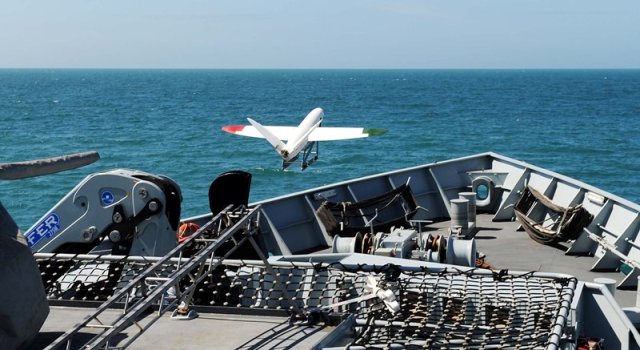A 3D printed unmanned aerial vehicle (UAV), designed and built at the University of Southampton, was successfully test launched from the front of the Royal Navy warship, HMS Mersey, and landed safely on a Dorset beach.
 UAV launches from HMS Mersey
UAV launches from HMS Mersey
The aircraft weighed 3 kg and measured 1.5 m. Laser sintered nylon was used to build the airframe on a 3D printer. For the purpose of recording the flight, the aircraft was fitted with a small video camera and the flight was monitored by University engineers from their UAV control van equipped with on-board video cameras.
The flight covered around 500m, with a flight time of just a few minutes. This was a successful demonstration of the prospective use of small lightweight UAVs in the future. One of the key advantages is that it can be easily launched at sea in a maritime environment.
Professor Andy Keane, from Engineering and the Environment at the University of Southampton, says: “The key to increased use of UAVs is the simple production of low cost and rugged airframes – we believe our pioneering used of 3D printed nylon has advanced design thinking in the UAV community world-wide.”
The Southampton engineers had developed and flown the SULSA UAV way back in 2011 for the first time, earning it the title of the world’s first entirely “printed” aircraft.
The cruise speed of the trialled aircraft was 50kts (58mph), but the plane could fly nearly silently.
The aircraft, which can be assembled without using tools, was printed in four main parts.
The capability demonstration was witnessed by the Royal Navy’s Commander Maritime Capability (Aviation), Cdr Bow Wheaton, who said:
The Royal Navy’s Maritime Capability organisation is very interested in conceptual applications of unmanned and highly automated systems.We were delighted to assist the University of Southampton with development of their 3-D printed unmanned air vehicle and provide a ship for an embarked launch.
Southampton alumnus, First Sea Lord Admiral Sir George Zambellas (Aeronautics, 1980) championed the involvement of the Navy in the project, known as Project Triangle, which in turn provided the chance to use a maritime platform for the test flight.
Adm Zambellas said: “Radical advances in capability often start with small steps. The launch of a 3D-printed aircraft from HMS Mersey is a small glimpse into the innovation and forward thinking that is now embedded in our Navy's approach. It's well known that our first squadron of remotely piloted aircraft have proven their worth in the Gulf, providing persistent airborne surveillance across huge areas of sea."
He also highlighted how this test could enable further exploration of simple, automated systems as alternatives to complex machines.
“We are after more and greater capability in this field which delivers huge value for money. And, because it's new technology, with young people behind it, we're having fun doing it," Adm Zambellas said.